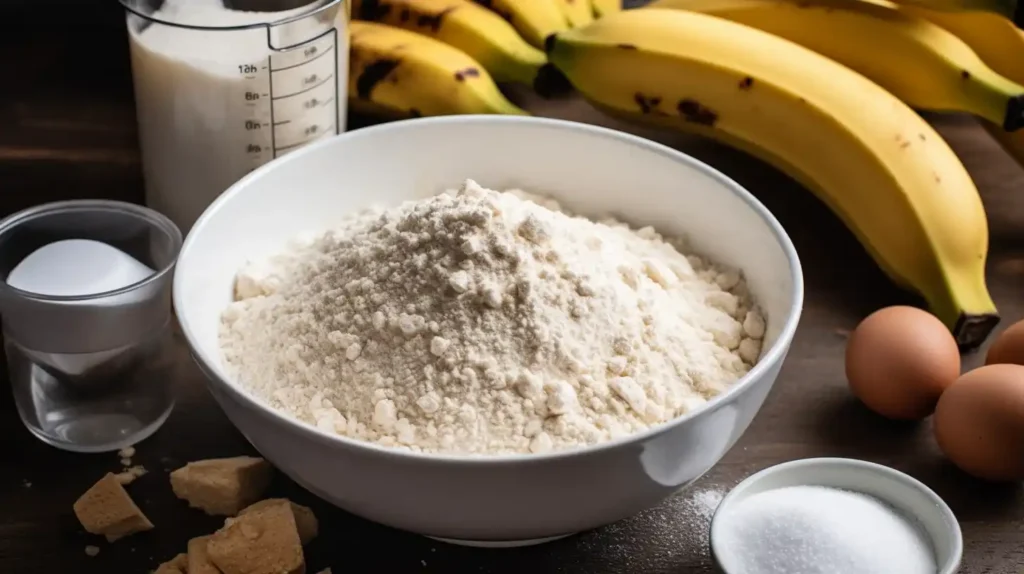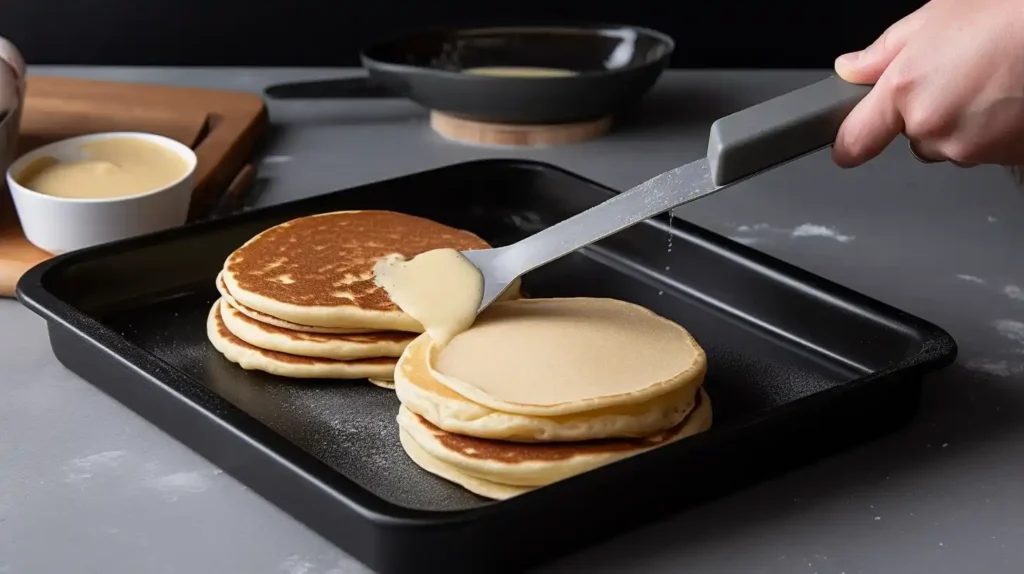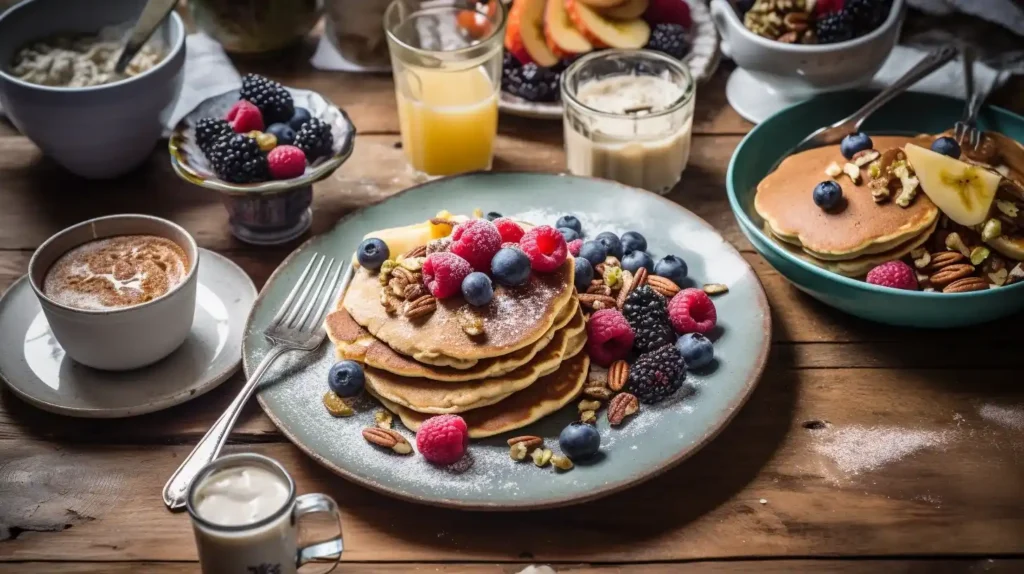Have you ever wondered, “Can I replace flour with protein powder in pancakes?”
It’s a common question among fitness enthusiasts, those on specialized diets, or anyone seeking to boost the protein content of their meals. The idea of swapping flour for protein powder is appealing for its nutritional benefits, but it’s important to understand how this substitution impacts the texture, flavor, and success of your pancakes.
In this guide, we’ll examine whether protein powder can effectively replace flour and how to create delicious, fluffy pancakes using this high-protein alternative.
Table of contents
What is Protein Powder?
Protein powder is a popular supplement that helps boost daily protein intake. Commonly used by athletes, fitness enthusiasts, and those on high-protein diets, it supports muscle growth, aids recovery, and promotes overall health.

Types of Protein Powder
There are several types of protein powder, each catering to different dietary needs:
- Whey Protein: The most popular type, derived from milk. It’s fast-digesting, versatile, and perfect for post-workout recovery.
- Plant-Based Protein: Includes options like pea, soy, and rice protein. These are ideal for vegans and individuals with dairy intolerance.
- Casein Protein: Another milk-derived protein, slower to digest, making it great for sustained energy.
Benefits of Protein Powder
- High Protein Content – Typically offers 20–30 grams of protein per serving.
- Versatility – Can be added to smoothies, baked goods, and meals like pancakes.
- Diet-Friendly – Many options are low-carb, gluten-free, and suitable for weight management.
Looking for something sweet? Try this delicious and stunning dessert: Princess Cake.
What is Flour’s Role in Pancakes?
Flour is a fundamental ingredient in pancake recipes, playing several critical roles that impact the texture, flavor, and structure of the dish. Understanding its purpose can help when substituting or adjusting ingredients like protein powder.
Functions of Flour in Pancakes
- Structure and Binding:
- Flour contains gluten (in non-gluten-free varieties), which acts as a binding agent, holding the batter together.
- This gives pancakes their soft, fluffy, and elastic texture.
- Absorbing Liquids:
- Flour absorbs moisture from milk, eggs, or water, creating a cohesive batter that’s easy to pour and cook.
- Achieving the Right Texture:
- The fine consistency of flour contributes to the light and airy texture of pancakes.
- Flavor Balance:
- While subtle, flour adds a mild, neutral flavor that complements sweet or savory toppings.
Why It’s Essential
Without flour, pancakes would lack their characteristic structure and fluffiness, turning out flat and crumbly. Even when using substitutes like protein powder, flour is often necessary to maintain balance in the recipe.
Can Protein Powder Replace Flour?
Using protein powder instead of flour is possible but requires careful adjustments. Protein powder lacks gluten, which is essential for structure and elasticity in baked goods, including pancakes.
When Protein Powder Works
- Replace 1/3 to 1/2 of the flour to retain texture while boosting protein content.
- Combine with other flours like almond or oat flour for a balanced texture.
- Works well in no-bake recipes or smoothies.
Differences Between Protein Powder and Flour
- Binding and Structure:
- Flour contains gluten (in non-gluten-free varieties), which provides elasticity and structure to baked goods.
- Protein powder lacks gluten, making it unsuitable for recipes requiring strong binding, like bread.
- Texture:
- Flour creates a soft, fluffy texture.
- Protein powder can make recipes dense or dry without adjustments.
- Nutrition:
- Flour is high in carbs and lower in protein.
- Protein powder is rich in protein and often low in carbs, ideal for fitness and weight management.
When Protein Powder Works as a Replacement
- Replace 1/3 to 1/2 of the flour in pancakes, waffles, or muffins to increase protein content.
- Combine protein powder with other flours like almond or oat flour for better texture.
- Works best in no-bake recipes or smoothies where binding is less critical.
Key Differences Between Protein Powder and Flour
- Gluten Content:
- Flour contains gluten (unless gluten-free), which provides elasticity and structure to baked goods.
- Protein powder lacks gluten, so it cannot replicate the same binding and structural properties.
- Texture and Absorbency:
- Flour creates soft, light textures due to its finer consistency.
- Protein powder is more absorbent, which can make recipes dense or dry if not adjusted properly.
- Nutritional Profile:
- Flour: High in carbohydrates and lower in protein.
- Protein powder: High protein content and low carbs, ideal for muscle-building and low-carb diets.
When Protein Powder Can Replace Flour
While protein powder cannot fully replace flour in most recipes, it can be used as a partial substitute in the following situations:
- Pancakes and Waffles:
- Replace 1/3 to 1/2 of the flour with protein powder for a healthier, high-protein alternative.
- Muffins and Cookies:
- Combine protein powder with other flours like almond or oat flour to retain texture.
- Smoothies or No-Bake Recipes:
- Use protein powder in recipes that don’t rely on gluten or structural integrity.
Tips for Successful Substitution
To ensure the best results, follow these tips:
- Adjust Liquids:
- Protein powder absorbs more liquid than flour. Add extra milk, water, or other wet ingredients to maintain the right consistency.
- Combine with Other Flours:
- Mix protein powder with almond, oat, or all-purpose flour to balance texture and flavor.
- Choose the Right Protein Powder:
- Use unflavored or mildly flavored protein powder for versatile recipes. Vanilla or chocolate may work in desserts but could overpower savory dishes.
- Avoid Overcooking:
- Recipes with protein powder cook faster and can dry out. Lower the temperature slightly and monitor closely.
Limitations of Using Protein Powder as Flour
Despite its versatility, protein powder has limitations as a flour substitute:
- Texture Changes: May result in dense, rubbery, or dry baked goods.
- Flavor Impact: Some protein powders, especially flavored ones, can overpower the recipe.
- Reduced Binding: Without gluten, recipes may lack structure, making them crumbly.
Nutritional Comparison: Flour vs. Protein Powder
Understanding the nutritional differences can help you decide whether this swap aligns with your dietary goals.
- Flour:
- Lower protein content
- Higher carbohydrates
- Offers a neutral flavor
- Protein Powder:
- High protein per serving (typically 20-30g)
- Low in carbs (especially with whey or plant-based options)
- Adds a nutritional boost for those aiming to build muscle or stay fuller longer
By understanding the roles of protein powder and flour in pancakes, you’re better equipped to experiment in the kitchen and enjoy both the health benefits and delicious taste of your creations.
How to Use Protein Powder in Pancakes
Best Practices for Substituting Protein Powder for Flour
Using protein powder as a partial replacement for flour is a great way to boost protein content in your recipes, especially in pancakes. However, for optimal results, it’s essential to follow these best practices.
Ideal Ratios
- Replace 1/3 to 1/2 of the flour with protein powder. This ensures the recipe retains its structure and doesn’t become too dense or rubbery.
- Avoid replacing all the flour, as protein powder lacks gluten, which is crucial for binding and texture.
Mixing Protein Powder with Other Flours
Combining protein powder with other flours helps balance the texture:
- Almond Flour: Adds moisture and a nutty flavor. Ideal for low-carb recipes.
- Oat Flour: Provides a soft, fluffy texture and boosts fiber.
- All-Purpose Flour: Stabilizes the recipe while letting the protein powder shine.
Adjust Liquids and Ingredients
- Increase Moisture: Protein powder is more absorbent than flour. Add extra milk, water, or eggs to prevent dryness.
- Incorporate Moist Ingredients: Greek yogurt, mashed banana, or applesauce can enhance texture and keep the batter moist.
Cooking Tips
- Use medium-low heat to prevent overcooking, as protein powder tends to dry out quickly.
- Avoid overmixing the batter to maintain a light, airy texture.
By following these practices, you can successfully substitute protein powder for flour, creating healthier, protein-packed pancakes without sacrificing flavor or texture.

Protein Pancake Recipes Using Protein Powder
1. Classic Whey Protein Pancakes
Ingredients:
- 1 scoop whey protein powder (vanilla or unflavored)
- 1/2 cup oat flour
- 1 egg
- 1/2 cup milk or almond milk
- 1 tsp baking powder
Instructions:
- Mix the dry ingredients in one bowl and the wet ingredients in another.
- Mix until smooth, avoiding overmixing.
- Cook on a non-stick skillet over medium heat until bubbles form. Flip and cook until golden.
2. Vegan Pea Protein Pancakes
Ingredients:
- 1 scoop pea protein powder
- 1/2 cup almond flour
- 1/4 cup applesauce
- 1/2 cup plant-based milk
- 1 tsp baking powder
Instructions:
- Whisk all ingredients into a thick batter.
- Pour small portions onto a greased skillet over low heat.
- Flip when edges are set and cook until done.
3. Chocolate Protein Pancakes
Ingredients:
- 1 scoop chocolate protein powder
- 1/4 cup oat flour
- 1/2 banana, mashed
- 1 egg
- 1/2 cup milk
Instructions:
- Blend ingredients into a smooth batter.
- Cook on a non-stick pan in small portions to ensure even cooking.
- Serve with toppings like fresh berries or a drizzle of honey.
Tips for Perfect Protein Pancakes
Cooking Techniques
- Cook on medium-low heat to avoid burning and ensure the pancakes cook through evenly.
- Use a lightly greased, non-stick skillet or griddle for consistent results.
Additional Ingredients to Enhance Flavor and Texture
- Sweeteners: Add honey, maple syrup, or a pinch of stevia to taste.
- Spices and Extracts: Enhance flavor with cinnamon, nutmeg, or vanilla extract.
- Toppings and Mix-Ins: Include blueberries, chocolate chips, or chopped nuts for added flavor and texture.
Common Mistakes and How to Avoid Them
- Overloading Protein Powder: Stick to suggested ratios to avoid dense, chalky pancakes.
- Skipping Extra Liquid: Always adjust the liquid ratio to maintain a smooth, pourable batter.
- Overmixing: Stir ingredients just until combined to keep the pancakes light and fluffy.
By following these recipes and tips, you’ll be able to create delicious, high-protein pancakes that suit your taste and dietary goals!
FAQs: Protein Powder as a Flour Substitute
If you’re considering using protein powder instead of flour, you may have some questions about how it works and its limitations. Here are answers to some of the most frequently asked questions:
Can I completely replace flour with protein powder?
- No, replacing 100% of the flour with protein powder is not recommended. Protein powder lacks gluten and binding properties, which can result in dense, crumbly, or dry baked goods. Instead, use it as a partial substitute, replacing 1/3 to 1/2 of the flour.
Which type of protein powder is best for pancakes?
- Whey Protein: Produces smooth, fluffy pancakes with a mild flavor.
- Plant-Based Protein: Suitable for vegans but may need extra liquid to prevent dryness.
- Unflavored vs. Flavored: Unflavored is versatile, while flavored options like vanilla or chocolate add sweetness but may overpower some recipes.
Why do my protein pancakes turn out dry and crumbly?
- This often happens because protein powder absorbs more liquid than flour. To fix this:
- Add extra milk or eggs to the batter.
- Include moist ingredients like Greek yogurt, mashed banana, or applesauce.
How can I improve the taste of protein pancakes?
- Enhance flavor with:
- Spices like cinnamon or nutmeg
- Vanilla extract
- Natural sweeteners such as honey or maple syrup
- Mix-ins like blueberries, chocolate chips, or nuts
Are protein powder pancakes suitable for specific diets?
- Yes! They can fit:
- Keto diets: Use low-carb protein powders and almond flour.
- Gluten-free diets: Combine protein powder with gluten-free flours like oat or almond flour.
- High-protein diets: Perfect as a post-workout meal.
Conclusion
Incorporating protein powder into pancake recipes is a fantastic way to boost their nutritional value without sacrificing flavor. While it’s not a perfect one-to-one substitute for flour, using it as a partial replacement can yield excellent results when done correctly.
Key Takeaways
- Balance is Key: Replace 1/3 to 1/2 of the flour with protein powder to maintain texture and structure while enhancing protein content.
- Adjust for Moisture: Compensate for protein powder’s absorbent nature by increasing liquid ingredients like milk or eggs.
- Choose the Right Protein Powder: Whey protein is ideal for fluffy pancakes, while plant-based options work well for vegan diets. Flavored powders add sweetness but should be used cautiously to avoid overpowering the recipe.
Why Try Protein Powder Pancakes?
- They are a healthy alternative for fitness enthusiasts, those on high-protein diets, or anyone looking for a more nutritious breakfast option.
- Versatile and customizable, you can experiment with flavors, toppings, and mix-ins to suit your taste and dietary needs.
By understanding how to use protein powder effectively, you can enjoy delicious, fluffy pancakes that are packed with nutrition. Whether for breakfast, post-workout fuel, or a snack, protein pancakes are a creative and satisfying way to achieve your health goals.


